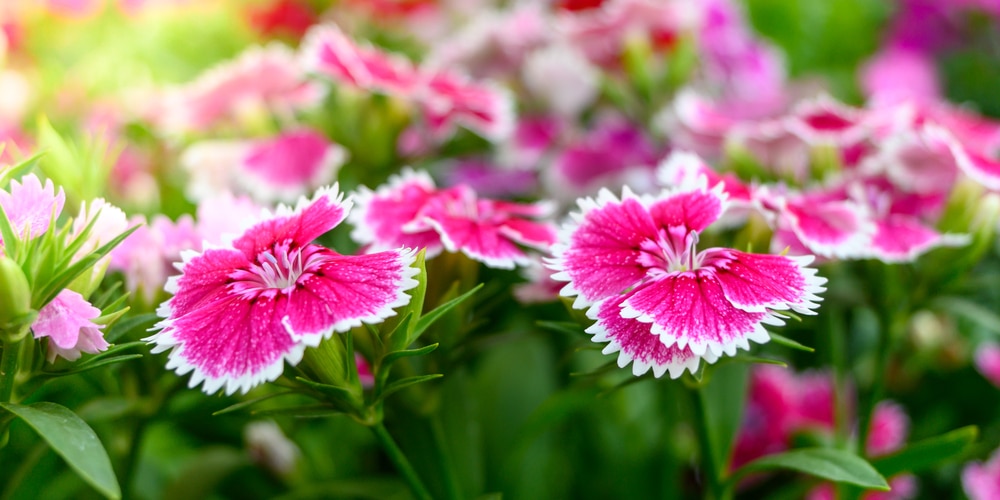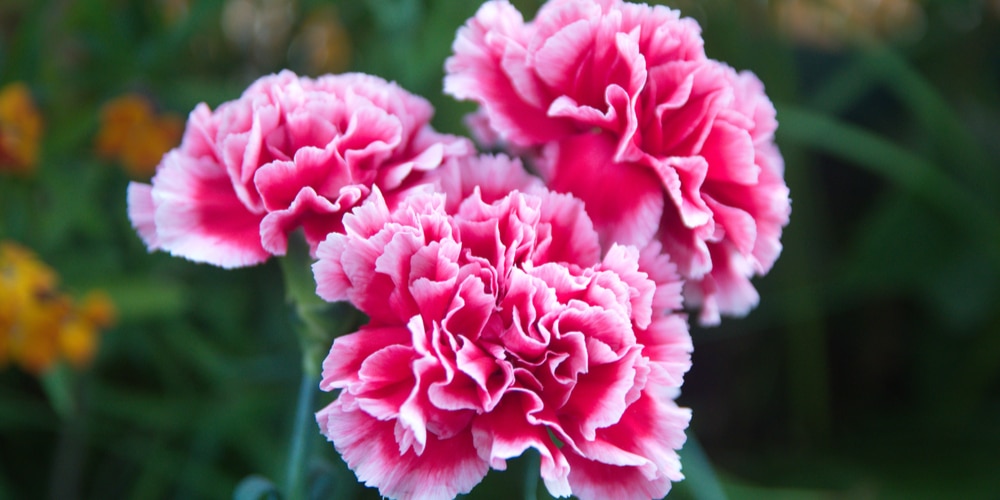Dianthus is a genus of pink flowers prized by gardeners for their beauty and variety. Its foliage is usually blue-green, with gorgeous blooms in shades of pink, white, or red. Dianthus plants are native to Europe and Asia, but they have been introduced to North America, where they are now widely cultivated.
Additionally, these exceptionally pretty flowers are often used as borders or bedding plants. They are also excellent cut flowers, with a long vase life. Dianthus plants come in many different varieties, such as ‘Sweet William,’ ‘Maiden Pinks’, and ‘Carnations.’
But do bees like Dianthus? The answer is yes! Its sweet nectar is highly attractive to bees, and the flowers are excellent pollen sources. In fact, all varieties of Dianthus are great for bees and other pollinators. So if you’re looking to attract bees to your garden, this is a plant you definitely want to consider!
Planting Dianthus in Your Garden Can Attract Pollinators
Gardeners love Dianthus for its gorgeous flowers and sweet fragrance. What many don’t know is that these beautiful blooms can also play an important role in attracting pollinators to the garden.
Bees, butterflies, hoverflies, and hummingbirds are all drawn to Dianthus, making it a great plant to add to any flower bed. And did we mention that Dianthus is also deer resistant?
This plant has a distinct clove-like fragrance that is most noticeable in the evening, repelling deer and other critters from your garden. Despite its strong scent, Dianthus is a great choice for both indoor and outdoor gardens.
The delicate petals of Dianthus are the perfect landing spot for weary pollinators, and the nectar-rich flowers provide a much-needed source of food. In fact, bees will often visit Dianthus before other flowers, making it an important part of the pollination process.
So not only is Dianthus a pretty addition to your garden, but it’s also an important player in the ecosystem!
Reasons Why You Should Have Dianthus in Your Garden
There are many reasons to add Dianthus to your garden, but here are some of our favorites:
Prized for their Gorgeous Blooms
Dianthus flowers come in a wide range of colors, from deep red to soft pink to pristine white. They also feature prominent fringes or “picotees” that add an extra touch of interest. And with over 300 varieties to choose from, there’s sure to be a dianthus variety that’s perfect for your garden.
Attracts Pollinators
As mentioned before, bees and other pollinators are drawn to dianthus flowers. By planting Dianthus in your garden, you can help support the local ecosystem and ensure that pollinators have the food they need to thrive.
Long-Blooming Season
Dianthus flowers typically bloom from early spring to late summer. With proper care, some varieties of Dianthus will even bloom throughout the fall! This makes Dianthus an excellent choice for gardeners who want continuous color in their gardens.
Low-Maintenance Plant
Dianthus is a versatile plant that can grow in a wide range of conditions, from full sun to partial shade. It’s also relatively drought-tolerant, so it’s perfect for those who don’t want to spend a lot of time watering their plants.
Sweet-Smelling Flowers
Many dianthus varieties are known for their sweet fragrance, which is often described as being similar to cloves. This delightful scent can be enjoyed in the garden or indoors, making Dianthus an excellent choice for both cutting gardens and potted plants.
Basic Dianthus Care
Of all the flowers in the garden, few are as versatile or easy to care for as Dianthus. Also known as sweet William or pinks, these hardy annuals come in a wide range of colors and sizes, making them ideal for everything from mass plantings to small containers.
Best of all, they require very little in the way of care, tolerating both heat and drought once they are established.
Dianthus are typically started from seed, although they can also be purchased as transplants from your local nursery. They can be sown directly in the garden after the last frost date or started indoors 4-6 weeks beforehand.
Once they have germinated, dianthus plants should be thinned so that they are spaced 12-18 inches apart. When transplanting, be sure to amend the soil with compost or another organic matter to improve drainage. Dianthus prefer full sun but will tolerate light shade, especially in hot summer climates.
Water dianthus regularly during the first growing season to help them become established. Once they are settled in, they will need very little supplemental irrigation except in cases of extreme drought.
Fertilize Dianthus twice a year – once in spring and again in mid-summer – with a balanced fertilizer such as an all-purpose granular fertilizer. Granular fertilizers should be worked into the soil before planting.
As Dianthus are short-lived perennials, they will need to be replaced every few years. However, they self-seed readily, so you may find new plants popping up in unexpected places around the garden. If you don’t want them to spread, simply deadhead the flowers after they have bloomed.
Do bees like dianthus: Final Thoughts
The delicate blooms of the Dianthus plant are a favorite of bees, which are drawn to the nectar-rich flowers. In return for their pollination services, bees help to ensure that the Dianthus plant will produce a bountiful crop of seeds.
As a result, beekeepers often place hives near fields of Dianthus to take advantage of the plant’s ability to attract these essential pollinators. In addition to its value to beekeepers, the Dianthus plant is also prized by gardeners for its beauty and fragrance.
If you’re on the lookout for a plant that will attract bees to your garden, the Dianthus is a great choice. This low-maintenance plant is easy to care for and provides continuous color throughout the growing season.
Plus, its sweet-smelling flowers are sure to please both you and the bees!
Related Article: Can Dianthus Survive Frost


